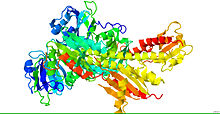| Phytochrome | |||||||||
|---|---|---|---|---|---|---|---|---|---|
 Crystal structure of phytochrome.[1] | |||||||||
| Identifiers | |||||||||
| Symbol | Phytochrome | ||||||||
| Pfam | PF00360 | ||||||||
| InterPro | IPR013515 | ||||||||
| |||||||||

Phytochromes are a class of photoreceptor proteins found in plants, bacteria and fungi. They respond to light in the red and far-red regions of the visible spectrum and can be classed as either Type I, which are activated by far-red light, or Type II that are activated by red light.[2] Recent advances have suggested that phytochromes also act as temperature sensors, as warmer temperatures enhance their de-activation.[3] All of these factors contribute to the plant's ability to germinate.
Phytochromes control many aspects of plant development. They regulate the germination of seeds (photoblasty), the synthesis of chlorophyll, the elongation of seedlings, the size, shape and number and movement of leaves and the timing of flowering in adult plants. Phytochromes are widely expressed across many tissues and developmental stages.[2]
Other plant photoreceptors include cryptochromes and phototropins, which respond to blue and ultraviolet-A light and UVR8, which is sensitive to ultraviolet-B light.
- ^ PDB: 3G6O; Yang X, Kuk J, Moffat K (2009). "Crystal structure of P. aeruginosa bacteriaphytochrome PaBphP photosensory core domain mutant Q188L". Proc. Natl. Acad. Sci. U.S.A. 106 (37): 15639–15644. doi:10.1073/pnas.0902178106. PMC 2747172. PMID 19720999.
- ^ a b Li J, Li G, Wang H, Wang Deng X (2011). "Phytochrome signaling mechanisms". The Arabidopsis Book. 9: e0148. doi:10.1199/tab.0148. PMC 3268501. PMID 22303272.
- ^ Halliday, Karen J.; Davis, Seth J. (2016). "Light-sensing phytochromes feel the heat" (PDF). Science. 354 (6314): 832–833. Bibcode:2016Sci...354..832H. doi:10.1126/science.aaj1918. PMID 27856866. S2CID 42594849.